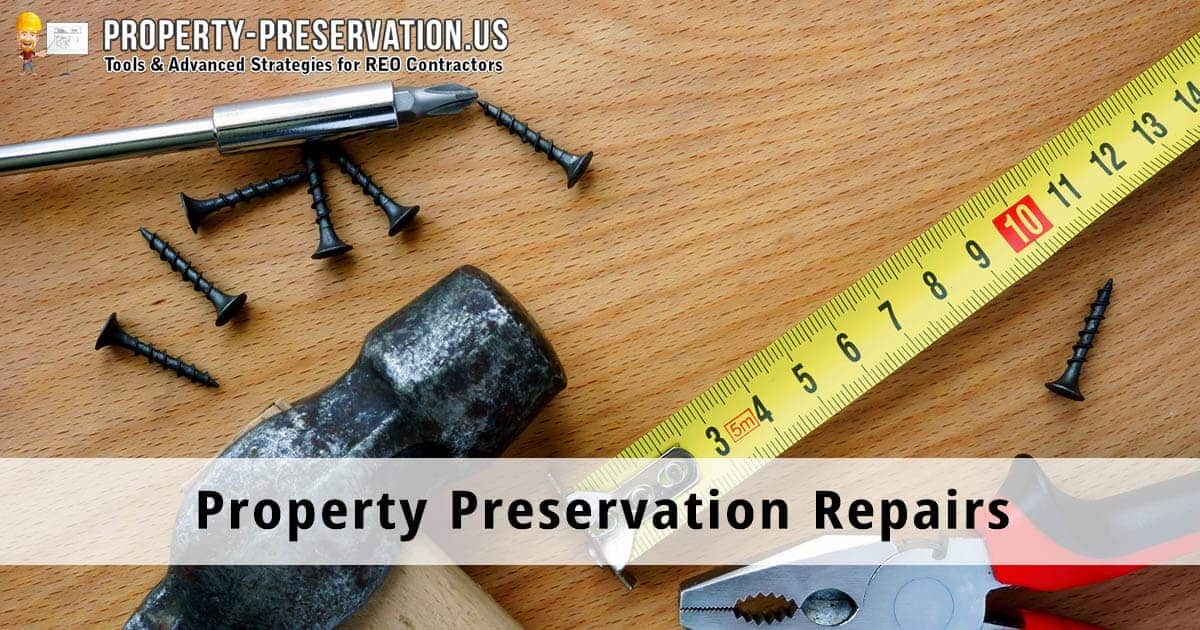Believe it or not, many banks are actively renovating their foreclosure houses in an attempt to sell them for the most amount of money in the least amount of time. Banks are also forced to complete repairs to cure city code violations and to address damages related to an insurance claim.
Repair Vendors need to know how to use basic estimating software, be able to give accurate start and finish dates, and have all the necessary equipment and crew(s) or subcontractors to complete these repairs as quickly as possible. Construction knowledge is a must to be a successful repair vendor.
As a repair vendor, you will be hired to complete 2 types of work orders:
- Bid Orders
- Repair Orders
A Bid Order is when your client sends you a request to physically inspect a property and then prepare an itemized estimate to repair “damages”. Your client will normally tell you exactly what type of damages they want you to estimate. These repairs can include but are not limited to roof repairs or replacement, total rehabs, repairs to correct damages such as theft damage, water damage, vandalism damage, disaster damages, etc.
A Repair Order is when your bid (estimate) gets approved, and your client sends it over to you as a request to complete the repairs per your bid. You would then take the necessary steps to complete the repairs or arrange to have them completed using your own network of independent contractors.
How to Handle Damages
Responsibility to Report
As a property preservation contractor, it is important to remember that you are assuming responsibility for the preservation and protection of all the properties that you work on. This responsibility is not limited to the services detailed on your work order. As a professional, you are expected to consider all other aspects of the property as well and identify and report all damages. You could be held responsible if damage is found to the property you have been working on further down the line.
Income Opportunities with Damages
Why not consider the job of looking for and reporting damages and problems as a potential income opportunity? In the industry, companies often complain that contractors limit themselves to performing only the work stated on the work order. It is very easy to look for extra work that needs to be done and bid on it.
Of course, most work has to be pre-approved and a work order issued, but the servicer or lender may have already pre-approved some issues such as:
- health and safety
- code violations
- anything that could form the basis of legal action
Liability for Damages and the Benefits of Reporting
The real incentive to do a full inspection and report on every property you work at is that you could be liable for damages if you do not find and report these issues. This doesn’t have to be a problem – you can demonstrate your professionalism by finding, documenting, and reporting.
If you do find and report existing and potential problems whenever you visit a property, there is very little chance of you being held responsible for them. Imagine yourself in a situation where you have to defend your actions – if you have already reported on these issues, there won’t be a problem.
Your photographic and written documentation of damages and potential problems should be extensive, and your bid to correct the damage or problem should be professional and all inclusive. And don’t forget: Always keep a field log of your property preservation activities and keep it on file for seven years.
Timeliness of Damage Reports
All damages must be reported and a bid submitted for the extra work on the same day as the work is done. If damage or unusual problems are found such as infestation, leaks in the roof, fire or frost damage, they must be reported immediately. If the problem or potential for ongoing damages can be corrected, submit a bid to correct it. For example:
- If there is a leak in the roof, submit a bid to repair it.
- If there is an infestation, get an estimate from a licensed exterminator. They must complete any fumigation and present a copy of their license if required by local law.
- If a door or window is missing, bid to board or replace it, or build a security door with a hasp and padlock.
Insurance and Damage Reports
Property damage will always require detailed reporting and extensive photo documentation. Mortgage companies use property preservation repair bids to file insurance claims for
vandalism, storm, or structural damage.
This is one of the main reasons why contractors are held responsible if they don’t report damages in an accurate and timely fashion. Many insurance policies have a time limit for claims, and if the lender or servicer cannot collect on a claim because of you, they are going to get your errors and omissions insurance to pay up instead.
Someone Always Has to Pay
Properties may be repaired through contractor bids in order to put them into conveyance condition. Housing and Urban Development (HUD) requires clients to repair damages that it thinks the mortgage company may be responsible for because they have not secured the property, did not winterize properly, or did not carry out essential repairs that led to ongoing damages.
Bids need to be broken down into the following causes:
- Roof leaks
- Water
- Fire or smoke
- Vandalism
- Freezing
- Structural
- Mortgagor neglect such as occupant abuse
When reporting damage, it is essential to state whether the neglect is due to the mortgagor (homeowner) or mortgagee (client). You will always be required to provide an estimate of how much damage has occurred and identify the source.
The Bottom Line
Clients need accurate and timely reports. Make sure all the required information is supplied on
your initial report so that no follow-up is necessary. Follow-ups cause delay which has a negative effect on both the client’s recovery for the loss and on your income.





I am a startup in the foreclosure cleaning, and i have no experience in bidding or estimating property clean out, repairs and board up properties. How will i get the training i need to operate your software i am to purchase.
HECM trash out it says up to $15,000 do you know what that all involves this property has water in basement 10 inches deep and has been previously had sewer come up all drains leaving the whole house full of mold and soaked carpets all walls cupboards everything is moldy? They have allowable for pumping and mold cure but it’s no way near enough how would you handle this situation?
My property was vandalized. Wells Fargo, initially hired the preservation company. The insurance company representing the preservation company is threatening to deny my claim. I feel that they are taking advantage of me because my age is 88. My house has been unlivable for 11 months. How should I proceed?